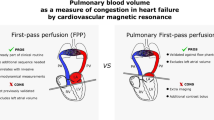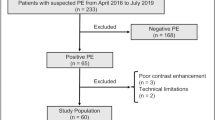Abstract
Objectives
In this pilot study we explored whether contrast-material bolus propagation time and speed in the pulmonary arteries (PAs) determined by dynamic contrast-enhanced computed tomography (DCE-CT) can distinguish between patients with and without pulmonary hypertension (PH).
Methods
Twenty-three patients (18 with and 5 without PH) were examined with a DCE-CT sequence following their diagnostic or follow-up right-sided heart catheterisation (RHC). X-ray attenuation over time curves were recorded for regions of interest in the main, right and left PA and fitted with a spline fit. Contrast material bolus propagation speeds and time differences between the peak concentrations were compared with haemodynamic parameters from RHC.
Results
Bolus speed correlated (ρ = −0.55) with mean pulmonary arterial pressure (mPAP) and showed a good discriminative power between patients with and without PH (cut-off speed 317 mm/s; sensitivity 100 %/specificity 100 %). Additionally, time differences between peaks correlated with mPAP (ρ = 0.64 and 0.49 for right and left PA, respectively) and discrimination was achieved with sensitivity 100 %/specificity 100 % (cut-off time 0.15 s) and sensitivity 93 %/specificity 80 % (cut-off time 0.45 s), respectively.
Conclusions
Bolus propagation speed and time differences between contrast material peaks in the PA can identify PH. This method could be used to confirm the indication for RHC in patients screened for pulmonary hypertension.
Key Points
• Dynamic contrast-enhanced computed tomography (CT) can identify patients with pulmonary hypertension.
• Bolus propagation speed in the pulmonary artery is reduced in pulmonary hypertension.
• Peak-contrast propagation times provide a practical surrogate for speed.
• This non-invasive technique could serve as a screening method for pulmonary hypertension.
• Invasive right-sided heart catheterisations might be restricted to a smaller group of patients.




Similar content being viewed by others
Abbreviations
- AVDO2 :
-
arterial-venous difference in oxygen content
- CM:
-
contrast material
- CO:
-
cardiac output
- IPAH:
-
idiopathic pulmonary arterial hypertension
- mPAP:
-
mean pulmonary artery pressure
- PA:
-
pulmonary artery
- PH:
-
pulmonary hypertension
- PVR:
-
pulmonary vascular resistance
- RHC:
-
right-sided heart catheterisation
- SO2 :
-
oxygen saturation
- t max :
-
time to peak
- Δt max :
-
propagation time between regions of interest
- v bolus :
-
propagation speed of CM bolus
- \( \overline{v_{bolus}} \) :
-
average propagation speed of CM bolus
References
Galie N, Hoeper MM, Humbert M et al (2009) Guidelines for the diagnosis and treatment of pulmonary hypertension. Eur Resp J 34:1219–1263
Simonneau G, Robbins IM, Beghetti M et al (2009) Updated clinical classification of pulmonary hypertension. J Am Coll Cardiol 54:S43–S54
Hoeper MM, Lee SH, Voswinckel R et al (2006) Complications of right heart catheterization procedures in patients with pulmonary hypertension in experienced centers. J Am Coll Cardiol 48:2546–2552
Lang IM, Plank C, Sadushi-Kolici R, Jakowitsch J, Klepetko W, Maurer G (2010) Imaging in pulmonary hypertension. JACC Cardiovasc Imaging 3:1287–1295
Okajima Y, Ohno Y, Washko GR, Hatabu H (2011) Assessment of pulmonary hypertension: What CT and MRI can provide. Acad Radiol 18:437–453
Stevens GR, Fida N, Sanz J (2012) Computed tomography and cardiac magnetic resonance imaging in pulmonary hypertension. Prog Cardiovasc Dis 55:161–171
Reiter G, Reiter U, Kovacs G et al (2008) Magnetic resonance-derived 3-dimensional blood flow patterns in the main pulmonary artery as a marker of pulmonary hypertension and a measure of elevated mean pulmonary arterial pressure. Circ Cardiovasc Imaging 1:23–30
Sanz J, Kuschnir P, Rius T et al (2007) Pulmonary arterial hypertension: noninvasive detection with phase-contrast MR imaging. Radiology 243:70–79
Chan AL, Juarez MM, Shelton DK et al (2011) Novel computed tomographic chest metrics to detect pulmonary hypertension. BMC Med Imaging 11:7
Miles KA, Lee T, Goh V et al (2012) Current status and guidelines for the assessment of tumour vascular support with dynamic contrast-enhanced computed tomography. Eur Radiol 22:1430–1441
Barfett JJ, Fierstra J, Mikulis DJ, Krings T (2010) Blood velocity calculated from volumetric dynamic computed tomography angiography. Invest Radiol 45:778–781
Ganz W, Donoso R, Marcus HS, Forrester JS, Swan HJC (1971) New technique for measurement of cardiac output by thermodilution in man. Am J Cardiol 27:392–396
International Commission on Radiological Protection ICRP (2007) The 2007 recommendations of the international commission on radiological protection. ICRP publication 103. Ann ICRP 37:1–332
Huda W, Magill D, He W (2011) CT effective dose per dose length product using ICRP 103 weighting factors. Med Phys 38:1261–1265
Helderman F, Mauritz G, Andringa KE, Vonk-Noordegraaf A, Marcus JT (2011) Early onset of retrograde flow in the main pulmonary artery is a characteristic of pulmonary arterial hypertension. J Magn Reson Imaging 33:1362–1368
Gruenig E, Barner A, Bell M et al (2011) Non-invasive diagnosis of pulmonary hypertension: ESC/ERS guidelines with updated commentary of the cologne consensus conference 2011. Int J Cardiol 154:S3–S12
Safdar Z, Katz M, Frost A (2010) Computed axial tomography evidence of left atrial enlargement: A predictor of elevated pulmonary capillary wedge pressure in pulmonary hypertension. Int J Gen Med 3:23–29
Bradlow WM, Gibbs JSR, Mohiaddin RH (2012) Cardiovascular magnetic resonance in pulmonary hypertension. J Cardiovasc Magn Reson 14:6
Ley S, Fink C, Risse F et al (2013) Magnetic resonance imaging to assess the effect of exercise training on pulmonary perfusion and blood flow in patients with pulmonary hypertension. Eur Radiol 23:324–331
Truong QA, Massaro JM, Rogers IS et al (2012) Reference values for normal pulmonary artery dimensions by noncontrast cardiac computed tomography the Framingham heart study. Circ Cardiovasc Imaging 5:147–154
Matthay RA, Schwarz MI, Ellis JH et al (1981) Pulmonary artery hypertension in chronic obstructive pulmonary disease: determination by chest radiography. Invest Radiol 16:95–100
Chetty KG, Brown SE, Light RW (1982) Identification of pulmonary-hypertension in chronic obstructive pulmonary-disease from routine chest radiographs. Am Rev Respir Dis 126:338–341
Bush A, Gray H, Denison DM (1988) Diagnosis of pulmonary-hypertension from radiographic estimates of pulmonary arterial size. Thorax 43:127–131
Tan R, Kuzo R, Goodman L et al (1998) Utility of CT scan evaluation for predicting pulmonary hypertension in patients with parenchymal lung disease. Chest 113:1250–1256
Ng C, Wells A, Paley S (1999) A CT sign of chronic pulmonary arterial hypertension: The ratio of main pulmonary artery to aortic diameter. J Thorac Imaging 14:270–278
Berty HL, Simon M, Chapman BE (2012) A semi-automated quantification of pulmonary artery dimensions in computed tomography angiography images. AMIA Annu Symp Proc 2012:36–42
Linguraru MG, Pura JA, Van Uitert RL et al (2010) Segmentation and quantification of pulmonary artery for noninvasive CT assessment of sickle cell secondary pulmonary hypertension. Med Phys 37:1522–1532
Edwards P, Bull R, Coulden R (1998) CT measurement of main pulmonary artery diameter. Br J Radiol 71:1018–1020
Devaraj A, Hansell DM (2009) Computed tomography signs of pulmonary hypertension: Old and new observations. Clin Radiol 64:751–760
Lee H, Kim SY, Lee SJ, Kim JK, Reddy RP, Schoepf UJ (2012) Potential of right to left ventricular volume ratio measured on chest CT for the prediction of pulmonary hypertension: correlation with pulmonary arterial systolic pressure estimated by echocardiography. Eur Radiol 22:1929–1936
Roeleveld R, Marcus J, Faes T et al (2005) Interventricular septal configuration at MR imaging and pulmonary arterial pressure in pulmonary hypertension. Radiology 234:710–717
Dellegrottaglie S, Sanz J, Poon M et al (2007) Pulmonary hypertension: Accuracy of detection with left ventricular septal-to-free wall curvature ratio measured at cardiac MRI. Radiology 243:63–69
Sauvage N, Reymond E, Jankowski A et al (2013) ECG-gated computed tomography to assess pulmonary capillary wedge pressure in pulmonary hypertension. Eur Radiol 23:2658–2665
Jardim C, Rochitte CE, Humbert M et al (2007) Pulmonary artery distensibility in pulmonary arterial hypertension: an MRI pilot study. Eur Resp J 29:476–481
Sanz J, Kariisa M, Dellegrottaglie S et al (2009) Evaluation of pulmonary artery stiffness in pulmonary hypertension with cardiac magnetic resonance. JACC Cardiovasc Imaging 2:286–295
Swift AJ, Rajaram S, Condliffe R et al (2012) Pulmonary artery relative area change detects mild elevations in pulmonary vascular resistance and predicts adverse outcome in pulmonary hypertension. Invest Radiol 47:571–577
Davarpanah AH, Hodnett PA, Farrelly CT et al (2011) MDCT bolus tracking data as an adjunct for predicting the diagnosis of pulmonary hypertension and concomitant right-heart failure. AJR Am J Roentgenol 197:1064–1072
Jeong HJ, Vakil P, Sheehan JJ et al (2011) Time-resolved magnetic resonance angiography: Evaluation of intrapulmonary circulation parameters in pulmonary arterial hypertension. J Magn Reson Imaging 33:225–231
Skrok J, Shehata ML, Mathai S et al (2012) Pulmonary arterial hypertension: MR imaging-derived first-pass bolus kinetic parameters are biomarkers for pulmonary hemodynamics, cardiac function, and ventricular remodeling. Radiology 263:678–687
Pienn M, Kovacs G, Tscherner M et al (2013) Determination of cardiac output with dynamic contrast-enhanced computed tomography. Int J Cardiovasc Imaging. doi:10.1007/s10554-013-0279-6
Acknowledgements
The authors would like to thank Wolfgang Loidl for his help in setting up the examination protocol, Dr. László Fóris for fruitful discussions, Dr. Daniela Kleinschek for retrieving patient data and Eugenia Lamont for the linguistic review.
Clinical trial registration: ClinicalTrials.gov (NCT01607489).
The preliminary data of this manuscript was presented as an oral presentation at the European Congress of Radiology 2013, Vienna, Austria.
This study was funded by the Ludwig Boltzmann Institute for Lung Vascular Research.
None of the authors declared potential conflicts of interest.
Author information
Authors and Affiliations
Corresponding author
Electronic supplementary material
Below is the link to the electronic supplementary material.
ESM 1
(PDF 910 kb)
Rights and permissions
About this article
Cite this article
Pienn, M., Kovacs, G., Tscherner, M. et al. Non-invasive determination of pulmonary hypertension with dynamic contrast-enhanced computed tomography: a pilot study. Eur Radiol 24, 668–676 (2014). https://doi.org/10.1007/s00330-013-3067-8
Received:
Revised:
Accepted:
Published:
Issue Date:
DOI: https://doi.org/10.1007/s00330-013-3067-8




